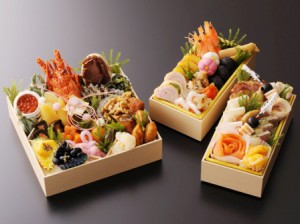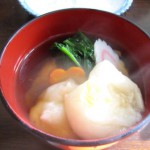A Happy New Year! あけましておめでとうございます。
I am Yoshi from NILS Japanese language school. Today, we would like to introduce some of the Japanese traditions and customs of New Year’s Day. The New Year is one of the most importannt holidays for the Japanese. During this season, the entrance of the house is decorated with pine branches, sacred straw ropes and talismans. In addition, there are many traditional events and activities going on.
初詣/はつもうで [Hatsumode/First visit to the Shinto Shrine]
Many Japanese people visit a Shinto shrine during the first three days of the New Year to make traditionas New Year’s wishes for health and happiness. Some shrines like Dazaifu Tenmangu Shrine in Fukuoka attract more than two million worshippers every year. Since the shrine is opened specially on the night of New Year’s Eve, some people arrive there right after they hear the Joyanokane, the bell which rings out the old year. Hatsumode is one of the few occasions when people wear kimonos.
おせち料理/おせちりょうり [Osech-Ryori]
Osechi-ryori are specially prepared New Year’s dishes to be eaten during the first three days of the New Year. Most dishes are cooked in order to be preserved for at least three days so women don’t have to cook during that period. There are some regional differences in the contents of osechi, but most of them are common to all areas in Japan.

鏡餅/かがみもち [Kagamimochi]
Kagamimochi are sets of two round, flat rice cakes. A smaller one is placed on top of a larger one. Rice cakes have been considered a sacred food since ancient times because rice cultivation has always been indispensable for the Japanese.

雑煮/ぞうに [Zoni]
Zoni is another traditional New Year’s dish. Zoni is soup containing mochi (rice cakes), veitables and other ingredients such as chicken or seafood. There are some regional differences in the shape of mochi (round or square), soup (soy sauce based or miso based), etc, but a wide variety of ingredients used for zoni are particular to the region where it’s made.

年賀状/ねんがじょう [Nengajo/New Year Postcards]
There is a custom to exchange New Year postcards with personal or business acquaintances in Japan. On these cards, fixed phrases of thanks for the year gone by and greetings for the New Year are written. This is similar to the Western practice of exchanging Christmas cards.
Many of the students learning Japanese at NILS spent the first New Year’s Day in Japan. We hope all of you will have a joyous year of 2014!
January 6th News, from NILS Japanese language school
Happy New Year
01/06/2014
Uncategorized










